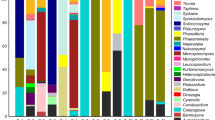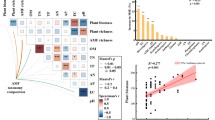Abstract
The population density of actinomycetes in the samples of light sierozem from the Kopet Dag piedmont plain (75 km from Ashkhabad, Turkmenistan) reaches hundreds of thousand CFU/g soil. The actinomycetal complex is represented by two genera: Streptomyces and Micromonospora. Representatives of the Streptomyces genus predominate and comprise 73 to 87% of the actinomycetal complex. In one sample, representatives of the Micromonospora genus predominated in the complex (75%). The Streptomyces genus in the studied soil samples is represented by the species from several sections and series: the species of section Helvolo-Flavus series Helvolus represent the dominant component of the streptomycetal complex; their portion is up to 77% of all isolated actinomycetes. The species of other sections and series are much less abundant. Thus, the percentage of the Cinereus Achromogenes section in the actinomycetal complex does not exceed 28%; representatives of the Albus section Albus series, Roseus section Lavendulae-Roseus series, and Imperfectus section belong to rare species; they have been isolated not from all the studied samples of light sierozem, and their portion does not exceed 10% of the actinomycetal complex.
Similar content being viewed by others
References
G. F. Gauze, T. P. Preobrazhenskaya, M. A. Sveshnikova, L. P. Terekhova, and T. S. Maksimova, Guide for Identification of Actinomycetes (Nauka, Moscow, 1983) [in Russian].
Salt-Affected Soils of Russia, Ed. by L. L. Shishov and E. I. Pankova (Akademkniga, Moscow, 2006) [in Russian].
D. G. Zvyagintsev and G. M. Zenova, Ecology of Actinomycetes (GEOS, Moscow, 2001) [in Russian].
G. M. Zenova, Soil Actinomycetes of Rare Genera (Moscow State Univ., Moscow, 2000) [in Russian].
G. M. Zenova, Diversity of Actinomycetes in Terrestrial Ecosystems (Moscow State Univ., Moscow, 2002) [in Russian].
Zh. Norovsuren, G. V. Oborotov, G. M. Zenova, R. A. Aliev, and D. G. Zvyagintsev, “Haloalkaliphilic actinomycetes in soils of Mongolian desert steppes,” Biol. Bull. 34 (4), 417–422 (2007).
T. A. Sokolova, “Specificity of soil properties in the rhizosphere: analysis of literature data,” Eurasian Soil Sci. 48 (9), 968–980 (2015). doi 10.1134/S1064229315050099
N. A. Manucharova, E. M. Kol’tsova, A. L. Stepanov, E. V. Demkina, V. A. Demkin, and G. I. El’Registan, “Comparative analysis of the functional activity and composition of hydrolytic microbial complexes from the lower Volga barrow and modern chestnut soils,” Microbiology 83 (5), 674–683 (2014).
Bergey’s Manual of Systematic Bacteriology, Ed. by S. T. Williams, M. Sharpe, and J. A. Holt (Williams and Wilkins, Baltimore, 1989), Vol. 4.
Author information
Authors and Affiliations
Corresponding author
Additional information
Original Russian Text © G.M. Zenova, D.G. Zvyagintsev, N.A. Manucharova, O.A. Stepanova, I.Yu. Chernov, 2016, published in Pochvovedenie, 2016, No. 10, pp. 1214–1217.
Rights and permissions
About this article
Cite this article
Zenova, G.M., Zvyagintsev, D.G., Manucharova, N.A. et al. Actinomycetal complex of light sierozem on the Kopet-Dag piedmont plain. Eurasian Soil Sc. 49, 1145–1148 (2016). https://doi.org/10.1134/S106422931610015X
Received:
Published:
Issue Date:
DOI: https://doi.org/10.1134/S106422931610015X




